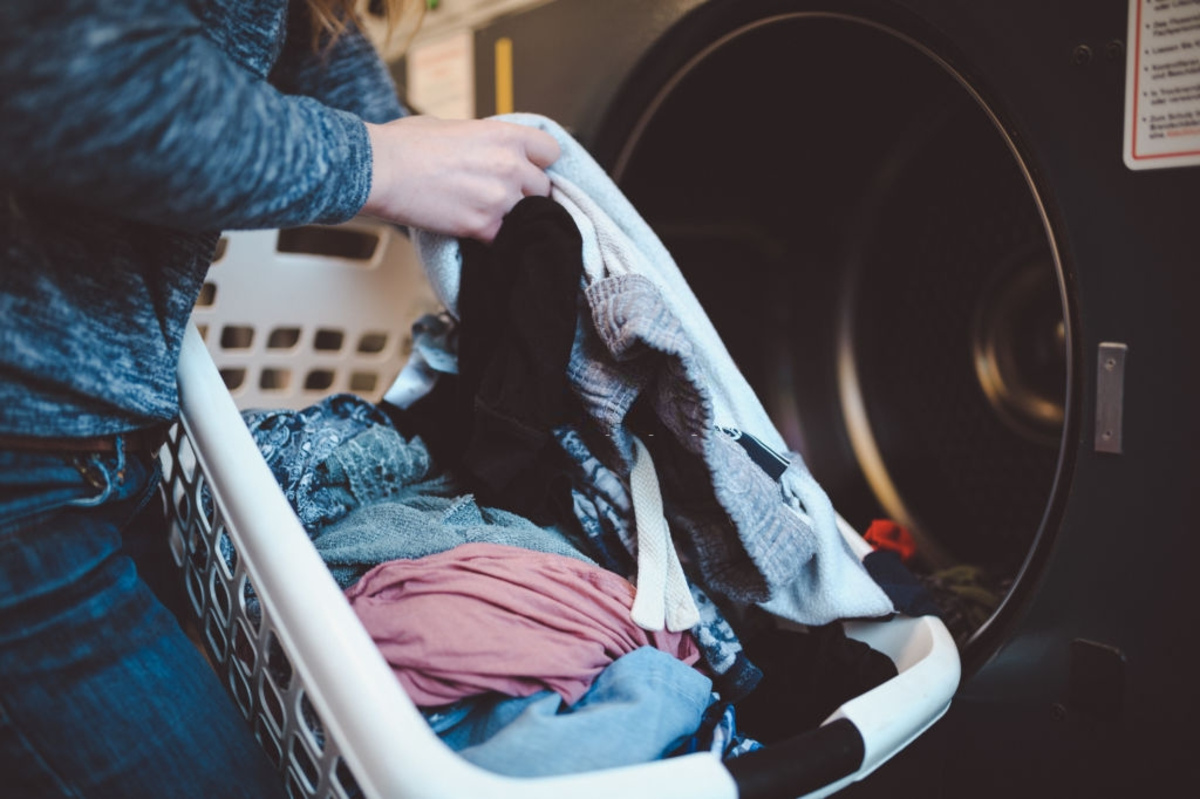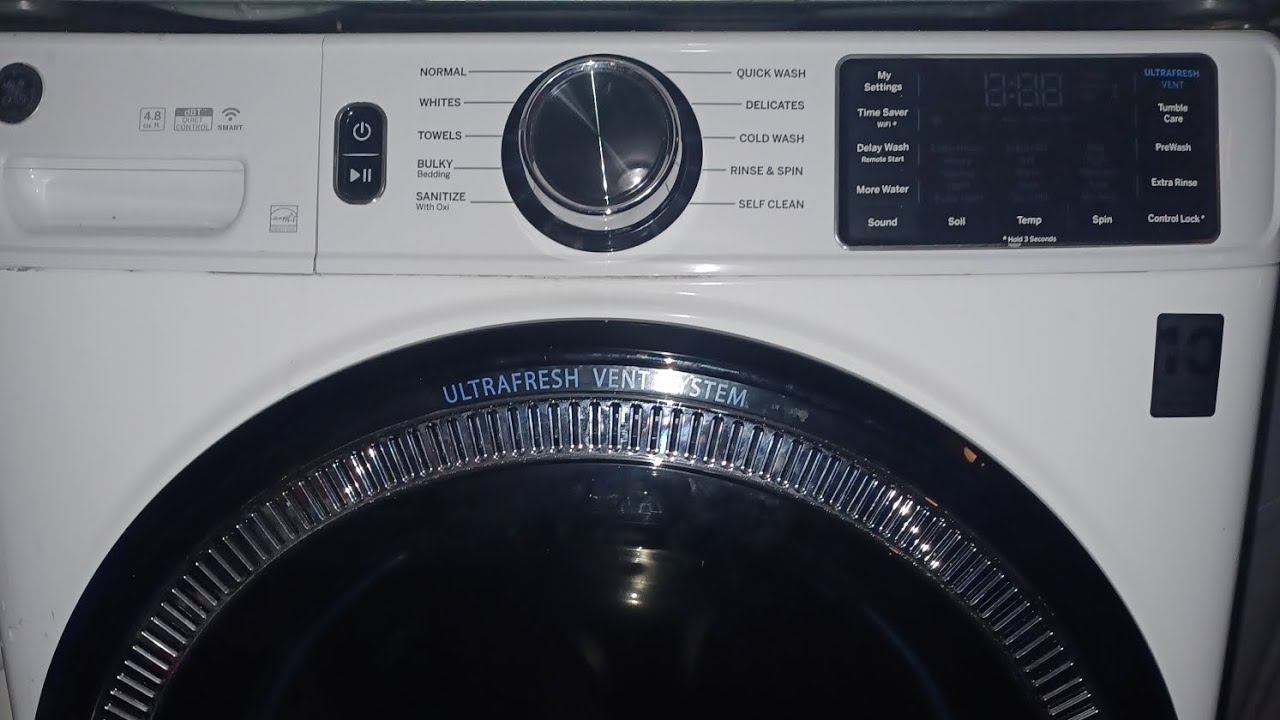Home>Storage Ideas>Bedroom Storage>Is It Best To Wash Clothes On Cold? Here’s What Experts Say


Bedroom Storage
Is It Best To Wash Clothes On Cold? Here’s What Experts Say
Modified: December 7, 2023
Discover the benefits of washing clothes on a cold setting and what the experts have to say about it. Explore the best choices for optimizing bedroom storage.
(Many of the links in this article redirect to a specific reviewed product. Your purchase of these products through affiliate links helps to generate commission for Storables.com, at no extra cost. Learn more)
Introduction
When it comes to doing laundry, there are many decisions to make: which detergent to use, how to sort the clothes, and, perhaps most crucially, what water temperature to select. Many people default to washing their clothes on warm or hot settings without considering the benefits of washing on cold. But is it really best to wash clothes on cold? Let’s dive in and explore what the experts have to say.
Over the years, some misconceptions have emerged about the effectiveness of cold-water washing. Many believe that hot water is necessary to remove stains and kill bacteria. However, with advancements in detergent formulations, washing clothes on cold has become much more efficient.
Not only does washing on cold offer several benefits for your clothes, but it also has a positive impact on the environment. Choosing cold water over warm or hot can significantly reduce energy consumption, conserving resources and lowering carbon emissions.
In this article, we’ll examine the various advantages of washing clothes on cold, discuss the environmental impact of cold-water washing, explore the effectiveness of this method, and provide tips for preserving the quality and color of your clothing. So, let’s get started and find out why washing clothes on cold might just be the best choice for your laundry routine.
Key Takeaways:
- Cold-water washing offers energy savings, environmental benefits, and fabric preservation. Modern detergents and proper care ensure effective stain removal and garment longevity.
- By embracing cold-water washing, you save energy, reduce your carbon footprint, and extend the lifespan of your clothes. Follow care instructions and use quality detergents for optimal results.
Benefits of Washing Clothes on Cold
Washing clothes on cold offers several benefits that make it a compelling choice for your laundry routine. Here are some of the advantages:
- Energy savings: One of the primary benefits of washing clothes on cold is the energy savings. Heating water accounts for a significant portion of energy consumption in washing machines. By using cold water, you can reduce your energy usage and save money on your utility bills. In fact, studies have shown that washing on cold can save up to 90% of the energy used for heating water compared to washing on a hot setting.
- Environmental impact: Choosing cold water over warm or hot has a positive impact on the environment. By reducing energy usage, you help conserve natural resources and decrease carbon emissions. This small change in your laundry routine can contribute to a more sustainable future.
- Preserving fabric quality: Cold-water washing is gentle on your clothes, helping to preserve their quality and extend their lifespan. Hot water can cause fabrics to fade, shrink, or lose their shape. By washing on cold, you minimize these risks and keep your clothes looking newer for longer.
- Color retention: Cold water is particularly beneficial for colored garments. When you wash on cold, the lower temperature helps prevent color bleeding and fading. Therefore, your vibrant and dark-colored clothes stay brighter and more vibrant over time.
- Stain removal: Contrary to popular belief, washing on cold can effectively remove stains. Modern detergents are formulated to work well in cold water, and many of them can break down and remove common stains even without the assistance of warm or hot water. For tougher stains, you can pre-treat them or use stain removers before washing.
By washing clothes on cold, you not only enjoy energy savings and environmental benefits but also preserve the quality and color of your garments. Plus, it’s an effective method for removing stains. Now that we’ve explored the benefits, let’s delve into the environmental impact of cold-water washing.
The Environmental Impact of Cold-Water Washing
When it comes to reducing our environmental impact, small changes in our daily routines can make a big difference. Washing clothes on cold is a simple yet effective way to minimize resource consumption and decrease carbon emissions. Here’s how cold-water washing positively affects the environment:
- Energy conservation: Heating water for laundry is energy-intensive. By choosing cold water, you can significantly reduce your energy consumption. According to the U.S. Department of Energy, around 90% of the energy used by washing machines goes towards heating water. By washing on cold, you can conserve this energy, leading to lower greenhouse gas emissions and a smaller carbon footprint.
- Water conservation: Using cold water means you don’t have to wait for the water heater to refill with hot water before starting your laundry. This helps conserve water as you can start the cycle immediately without wasting any while waiting for the water to heat up.
- Reduced detergent usage: Cold-water washing requires less detergent compared to hot water washes. This not only saves you money but also reduces the amount of detergent entering the wastewater system, minimizing its impact on the environment.
- Extended life of your washing machine: Washing on cold puts less strain on your washing machine’s heating and plumbing systems, extending their lifespan. This means fewer appliances in the landfill and a reduced environmental footprint associated with manufacturing and disposal.
- Avoiding microplastic pollution: Washing clothes in warm or hot water can cause synthetic fabrics to shed microplastics, which then end up in our waterways. By opting for cold-water washing, you can help reduce the release of microplastics, protecting aquatic life and ecosystems.
By making the simple switch to washing clothes on cold, you are not only saving energy and water but also minimizing detergent usage, extending the life of your washing machine, and reducing microplastic pollution. These collective actions have a positive impact on the environment and contribute to a more sustainable future. Now that we understand the environmental benefits, let’s explore the effectiveness of cold-water washing in cleaning your clothes.
Effectiveness of Cold-Water Washing
Many people are skeptical about the effectiveness of cold-water washing, believing that hot water is necessary to achieve a deep clean. However, advancements in detergent technology have made washing clothes on cold a highly effective method for cleaning. Here’s why:
- Modern detergents: Today’s detergents are formulated to work effectively in cold water. They contain enzymes and surfactants that are designed to break down and remove stains even without the assistance of hot water. These powerful formulations ensure that your clothes are thoroughly cleaned, even when washed on a cold setting.
- Pre-treatment options: For stubborn stains that may require a little extra attention, you can pre-treat them before washing. There are numerous stain removers and pre-treatment products available that are specifically formulated to tackle tough stains. Simply apply the product to the stain, let it sit for a while, and then wash your clothes on a cold cycle. This combination of pre-treatment and cold-water washing can effectively remove even the most stubborn stains.
- Proper garment care: It’s important to note that not all garments are suitable for cold-water washing, especially those that require special care or delicate fabrics. Always check the care label on your clothing items for washing instructions. However, for the majority of everyday clothing, cold-water washing is perfectly safe and effective.
- Bacteria and odor control: Contrary to popular belief, washing on cold can still effectively eliminate bacteria and control odors. While hot water may have a slight advantage in killing bacteria, cold-water washing combined with the right detergent is still sufficient to get rid of most germs and keep your clothes smelling fresh.
Overall, cold-water washing is highly effective in cleaning your clothes, thanks to modern detergent formulations and pre-treatment options. It’s important to follow garment care instructions and consider pre-treating tough stains when necessary. By choosing cold water, you can achieve a deep clean while enjoying the energy savings and environmental benefits we discussed earlier. Now, let’s explore how washing on cold helps preserve the quality and color of your clothing.
Preserving the Quality and Color of Clothing
One of the key advantages of washing clothes on cold is the ability to preserve the quality and color of your garments. Hot water can cause fabrics to fade, shrink, or lose their shape, which can significantly reduce their lifespan. Here’s how washing on cold helps maintain the quality and color of your clothing:
- Minimizing color fading: Cold water is gentler on fabrics and helps prevent color bleeding and fading. When you wash on cold, the lower temperature minimizes the strain on dyes used in the fabric, allowing your clothes to maintain their vibrant hues for longer. This is particularly important for colored garments and items with prints or patterns.
- Preserving fabric integrity: Hot water can be harsh on delicate fabrics, causing them to lose their shape or become misshapen. By washing on cold, you minimize the risk of damage and help your clothing retain its original shape. This is especially beneficial for items made from natural fibers like silk, wool, or cashmere.
- Reducing shrinkage: Heat is a major culprit when it comes to shrinking clothes. By avoiding hot water, you reduce the likelihood of shrinkage, particularly with shrink-prone fabrics such as cotton or wool. Washing on cold is especially important for delicate or tight-fitting garments that are more susceptible to shrinkage.
- Preserving garment elasticity: Elastic materials, such as those used in underwear, swimwear, and athletic apparel, can lose their stretch and elasticity when exposed to high temperatures. By washing these items on cold, you help maintain their elasticity, ensuring a better fit and longer lifespan.
By choosing to wash your clothes on cold, you can maintain the quality and color of your garments, preventing fading, shrinkage, and damage. This allows you to enjoy your favorite clothes for longer, saving you money in the long run. However, it’s important to note that certain types of clothing may require specific care. Let’s take a closer look at these considerations.
Washing clothes on cold can help save energy and prevent colors from fading. Use a cold water detergent for best results.
Read more: How To Fix E2 Error In A Washing Machine
Preventing Shrinkage and Damage
Shrinkage and damage can be a frustrating result of improper washing techniques. However, by following proper care instructions and utilizing cold-water washing, you can prevent shrinkage and minimize the risk of damage to your clothing. Here are some key tips to help you prevent shrinkage and damage:
- Read care labels: Before washing any garment, always check the care label for specific instructions. Some clothing items may require special care, such as hand washing or dry cleaning. It’s essential to follow these instructions to avoid any potential damage or shrinkage.
- Sort clothing properly: Sort your laundry based on color, fabric type, and care instructions. This ensures that items with similar washing requirements are grouped together, reducing the risk of damage and shrinkage during the washing process.
- Use the right temperature: While washing on cold is generally safe and effective, there may be instances where specific garments require warm or hot water. For example, heavily soiled items or bedding may benefit from a warmer temperature. Again, always refer to the care label for temperature guidelines.
- Avoid overloading the washing machine: Overloading the washing machine puts additional strain on your clothes and can lead to damage or ineffective cleaning. Be sure to leave enough space for your garments to move freely during the wash cycle.
- Protect delicates: Delicate fabrics, such as silk, lace, or cashmere, require extra care. Consider using a protective laundry bag or hand-washing delicate items to minimize the risk of damage or shrinkage. Cold-water washing is particularly beneficial for these fragile fabrics.
- Air dry or use low heat: After washing, opt for air drying whenever possible. Air drying helps prevent shrinkage and maintains the shape and integrity of your garments. If you choose to use a dryer, use a low heat setting to minimize any potential damage.
- Handle zippers and buttons carefully: To avoid snagging or tearing, always fasten zippers and buttons before tossing your garments into the washing machine. This simple step can significantly extend the lifespan of your clothing.
By implementing these prevention methods and incorporating cold-water washing into your laundry routine, you can protect your clothes from shrinkage and damage. However, it’s important to note that certain clothing items may require additional considerations. Let’s explore some of these considerations in the next section.
Considerations for Certain Types of Clothing
While cold-water washing is generally suitable for most everyday clothing items, there are certain types of garments that may require special considerations. Here are some key considerations for specific types of clothing:
- Delicate fabrics: Delicate fabrics such as silk, lace, or cashmere should be handled with extra care. Opt for cold-water washing and consider using a gentle or delicate cycle. It’s also a good idea to use a protective laundry bag to prevent any potential snags or damage.
- Wool and cashmere: Wool and cashmere garments require special care to prevent shrinkage and maintain their softness. Washing these items on cold with a detergent specifically designed for wool or cashmere is recommended. It’s best to avoid using the dryer and instead air dry these items flat to maintain their shape.
- Athletic wear: Performance fabrics, such as those used in athletic wear or activewear, often have special properties like moisture-wicking or odor resistance. Check the care label for specific washing instructions, but in most cases, cold-water washing is safe and effective for these garments. Avoid using fabric softeners as they can reduce the effectiveness of these performance features.
- Dark-colored clothing: Dark-colored clothing items are prone to fading over time. To preserve the color intensity, always wash them on cold and inside out. This helps minimize color bleeding and fading, ensuring that your dark garments maintain their richness and vibrancy.
- Printed or patterned garments: Similar to dark-colored clothing, printed or patterned garments can lose their color or design integrity over time. Cold-water washing helps preserve these details. To be extra cautious, turn these items inside out before washing to further protect the print or pattern.
- Denim: Denim can fade over time, especially when washed with warm or hot water. Washing denim on cold helps maintain its color and reduces the risk of shrinkage. It’s also best to turn denim garments inside out to minimize fading and preserve the appearance of the fabric.
- Stain-prone fabrics: Some fabrics, such as linen or cotton, are more prone to stains. If you encounter a tough stain on these fabrics, consider pre-treating it with a stain remover before washing on cold. This can help ensure effective stain removal without compromising the quality of the fabric.
By considering the specific care instructions and requirements for different types of clothing, you can ensure that your garments stay in excellent condition throughout their lifespan. Cold-water washing is generally safe and effective for most everyday clothing, but it’s important to make these adjustments for more delicate or specialized garments. Now, let’s explore some helpful tips for washing clothes on cold.
Tips for Washing Clothes on Cold
As you embrace the practice of washing clothes on cold, it’s essential to incorporate some helpful tips into your laundry routine. These tips will ensure that you maximize the effectiveness of cold-water washing and keep your clothes looking their best. Here are some valuable tips to consider:
- Use a quality detergent: Choose a high-quality detergent specially formulated for cold-water washing. These detergents contain enzymes and surfactants designed to work effectively in cold water, ensuring thorough cleaning and stain removal.
- Pre-treat tough stains: For stubborn stains, pre-treat them with a stain remover or a mixture of detergent and water. Gently work the solution into the stain, let it sit for a while, and then wash your clothes on a cold cycle. This extra step helps ensure effective stain removal even without hot water.
- Avoid overloading the washing machine: Leave enough space for your clothes to move freely during the wash cycle. Overloading the machine can result in inadequate cleaning and can be rough on your garments.
- Wash similar items together: Group similar items together based on fabric type, color, and care instructions. This ensures even cleaning and minimizes the risk of color bleeding or damage to delicate fabrics.
- Turn clothes inside out: Turn your clothes inside out before washing to protect the fabric and preserve color and design integrity. This is especially important for dark-colored items and garments with prints or patterns.
- Avoid excess detergent: Use the appropriate amount of detergent as recommended on the packaging. Using too much detergent can create build-up and reduce the effectiveness of the wash cycle.
- Consider a longer wash cycle: Cold-water washing may require a longer cycle to ensure proper cleaning. Check your washing machine’s settings and choose a cycle that provides adequate washing time for cold-water loads.
- Air dry whenever possible: Air drying is gentle on your clothes and helps prevent shrinkage and damage. Whenever you can, hang your laundry outside or use a drying rack indoors. If you use a dryer, opt for a low heat setting to avoid excessive heat exposure.
- Follow garment care instructions: Always refer to the care label on your clothing for specific washing instructions. Some items may have unique requirements or special considerations, and it’s important to follow these instructions to maintain the quality of your clothing.
By implementing these tips, you can optimize the effectiveness of cold-water washing and ensure that your clothes come out clean, fresh, and well-maintained. Washing on cold not only saves energy and helps the environment but also extends the lifespan of your garments. Now, let’s wrap up our discussion.
Conclusion
Choosing to wash clothes on cold offers a multitude of benefits for both you and the environment. From energy and cost savings to preserving the quality and color of your garments, cold-water washing proves to be a practical and eco-friendly laundry option. Contrary to common misconceptions, modern detergents are formulated to effectively clean clothes in cold water, making hot water unnecessary in most cases.
By opting for cold-water washing, you can significantly reduce your energy consumption and carbon footprint. You also minimize the risk of shrinking, fading, and damage to your clothes, ensuring that they last longer and remain in great condition. Additionally, cold-water washing provides a gentle yet effective method for removing stains and maintaining fabric integrity.
While cold-water washing is suitable for most everyday clothing, it’s important to consider specific care instructions for delicate fabrics, athletic wear, denim, and stained-prone garments. Taking precautions such as using a gentle cycle, turning clothes inside out, and pre-treating stubborn stains can further enhance the effectiveness of cold-water washing.
Remember to read and follow the care labels on your garments and use a quality detergent designed for cold-water washing. Avoid overloading your washing machine and consider air drying your clothes whenever possible to preserve their shape and color. By incorporating these tips into your laundry routine, you can optimize the benefits of washing on cold.
In conclusion, washing clothes on cold is a smart choice that combines efficiency, environmental responsibility, and garment care. So, why not make the switch to cold-water washing today? Your clothes, wallet, and the planet will thank you.
Frequently Asked Questions about Is It Best To Wash Clothes On Cold? Here’s What Experts Say
Was this page helpful?
At Storables.com, we guarantee accurate and reliable information. Our content, validated by Expert Board Contributors, is crafted following stringent Editorial Policies. We're committed to providing you with well-researched, expert-backed insights for all your informational needs.















0 thoughts on “Is It Best To Wash Clothes On Cold? Here’s What Experts Say”